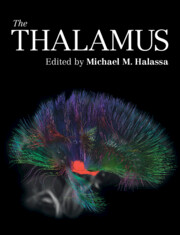Book contents
- The Thalamus
- The Thalamus
- Copyright page
- Contents
- Contributors
- Preface
- Section 1: History
- Section 2: Anatomy
- Section 3: Evolution
- Section 4: Development
- Section 5: Sensory Processing
- Section 6: Motor Control
- Section 7: Cognition
- Chapter 16 The Thalamus in Cognitive Control
- Chapter 17 The Thalamus in Attention
- Chapter 18 The Thalamus in Navigation
- Section 8: Arousal
- Section 9: Computation
- Index
- References
Chapter 18 - The Thalamus in Navigation
from Section 7: - Cognition
Published online by Cambridge University Press: 12 August 2022
- The Thalamus
- The Thalamus
- Copyright page
- Contents
- Contributors
- Preface
- Section 1: History
- Section 2: Anatomy
- Section 3: Evolution
- Section 4: Development
- Section 5: Sensory Processing
- Section 6: Motor Control
- Section 7: Cognition
- Chapter 16 The Thalamus in Cognitive Control
- Chapter 17 The Thalamus in Attention
- Chapter 18 The Thalamus in Navigation
- Section 8: Arousal
- Section 9: Computation
- Index
- References
Summary
The three anterior thalamic nuclei and the nucleus reuniens are essential for spatial navigation, yet their exact role in this function remains elusive. Specifically, it remains to be answered whether the thalamus acts a simple relay of spatial and executive signals or whether it critically operates on its inputs to convey processed signals to its cortical targets. The anterior thalamus and nucleus reuniens are at the center stage of anatomical networks that share one common aspect: their association with the hippocampus. Here, I review the large body of literature, starting from the classic Papez circuits, which describe how these thalamic nuclei are interconnected with subcortical, medial cortex, and parahippocampal regions, as well as their neuromodulatory inputs. I then provide an overview of the spatial and other electrophysiological correlates of anterior thalamic and reuniens neurons and of how their firing and oscillatory properties depend on ongoing behavior. Finally, I discuss the clinical and experimental evidence pointing to the role of the thalamus in navigation and, specifically, how spatial and executive signals are processed in thalamocortical loops. I conclude by discussing how the same thalamic circuits may be at play in the processing of episodic memories during sleep.
Keywords
- Type
- Chapter
- Information
- The Thalamus , pp. 340 - 360Publisher: Cambridge University PressPrint publication year: 2022

